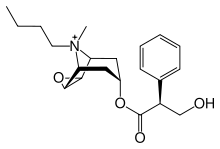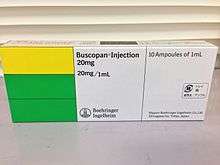Hyoscine butylbromide
 | |
| Clinical data | |
|---|---|
| Trade names | Buscopan |
| Pregnancy category |
|
| Routes of administration | By mouth, rectal, intravenous |
| ATC code | A03BB01 (WHO) |
| Legal status | |
| Legal status |
|
| Pharmacokinetic data | |
| Bioavailability | <1% |
| Protein binding | Low |
| Biological half-life | 5 hours |
| Excretion | Renal (50%) and fecal |
| Identifiers | |
| |
| CAS Number |
149-64-4 |
| PubChem (CID) | 160883 |
| DrugBank |
DB09300 |
| ChemSpider |
16736107 |
| UNII |
2Z3E1OF81V |
| ChEMBL |
CHEMBL1256901 |
| ECHA InfoCard | 100.005.223 |
| Chemical and physical data | |
| Formula | C21H30NO4+ |
| Molar mass | 360.467 g/mol |
| 3D model (Jmol) | Interactive image |
| |
| |
| | |
Hyoscine butylbromide, also known as scopolamine butylbromide[1] and sold under the brandname Buscopan,[2] is a medication used to treat crampy abdominal pain, esophageal spasms, renal colic, and bladder spasms.[2][3] It is also used to improve respiratory secretions at the end of life.[4] Hyoscine butylbromide can be taken by mouth, injection into a muscle, or into a vein.[2]
Side effects may include sleepiness, vision changes, triggering of glaucoma, and severe allergies.[2] Sleepiness however, is uncommon.[5] It is unclear if it is safe in pregnancy.[2] It is an anticholinergic agent,[2] which does not have much effect on the brain.[6]
It is on the WHO Model List of Essential Medicines, the most important medications needed in a basic health system.[7] It is not available in the United States.[8] The wholesale cost in the developing world is 0.004 to 0.11 USD per pill as of 2014.[9] It is manufactured from hyoscine which occurs naturally in the plant deadly nightshade.[10]
Medical uses

Hyoscine butylbromide is effective in treating crampy abdominal pain.[11]
Hyoscine butylbromide is effective in reducing the duration of the first stage of labour, and it is not associated with any obvious adverse outcomes in mother or neonate.[12]
It is also used during abdominal or pelvic MRI or CT scans to improve the quality of pictures.[13]
Pharmacology
It is a quaternary ammonium compound and a semisynthetic derivative of hyoscine hydrobromide (scopolamine). The attachment of the butyl-bromide moiety effectively prevents the movement of this drug across the blood–brain barrier, effectively minimising undesirable central nervous system side effects associated with scopolamine/hyoscine.
Abuse
Hyoscine butylbromide is not centrally active and has a low incidence of abuse.
References
- ↑ Juo, Pei-Show (2001). Concise Dictionary of Biomedicine and Molecular Biology. (2nd ed.). Hoboken: CRC Press. p. 570. ISBN 9781420041309.
- 1 2 3 4 5 6 "Buscopan Tablets and Ampoules". Therapeutic Goods Administration, Australia. 8 November 2010. Retrieved 22 October 2013.
- ↑ Hamilton, Richart (2015). Tarascon Pocket Pharmacopoeia 2015 Deluxe Lab-Coat Edition. Jones & Bartlett Learning. p. 270. ISBN 9781284057560.
- ↑ Paice, Judith (2015). Care of the Imminently Dying. Oxford University Press. p. 43. ISBN 9780190244309.
- ↑ Handbook of Palliative Care (3rd ed.). New York: Wiley. 2012. p. 570. ISBN 9781118426814.
- ↑ Hanks, Geoffrey (2011). Oxford textbook of palliative medicine (4th ed.). Oxford [etc.]: Oxford University Press. p. 805. ISBN 9780199693146.
- ↑ "WHO Model List of EssentialMedicines" (PDF). World Health Organization. October 2013. Retrieved 22 April 2014.
- ↑ Territo, editor, Dennis A. Casciato ; associate editor, Mary C. (2012). Manual of clinical oncology (7th ed.). Philadelphia: Wolters Kluwer/Lippincott Williams & Wilkins Health. p. 146. ISBN 9781451115604.
- ↑ "Hyoscine Butylbromide". International Drug Price Indicator Guide. Retrieved 4 December 2015.
- ↑ Twycross, Robert (2003). Introducing palliative care (4th ed.). Oxford: Radcliffe Medical Press. p. 172. ISBN 9781857759150.
- ↑ Tytgat, G. N. (2007). "Hyoscine Butylbromide: A Review of its Use in the Treatment of Abdominal Cramping and Pain". Drugs. 67 (9): 1343–1357. doi:10.2165/00003495-200767090-00007. PMID 17547475.
- ↑ Samuels, L. A.; Christie, L.; Roberts-Gittens, B.; Fletcher, H.; Frederick, J. (2007). "The effect of hyoscine butylbromide on the first stage of labour in term pregnancies". BJOG. 114 (12): 1542–1546. doi:10.1111/j.1471-0528.2007.01497.x. PMID 17903230.
- ↑ "Hyoscine butylbromide (Buscopan®)" (PDF). UK: Guy's and St Thomas' NHS Foundation Trust. July 2014. Retrieved 16 June 2016.